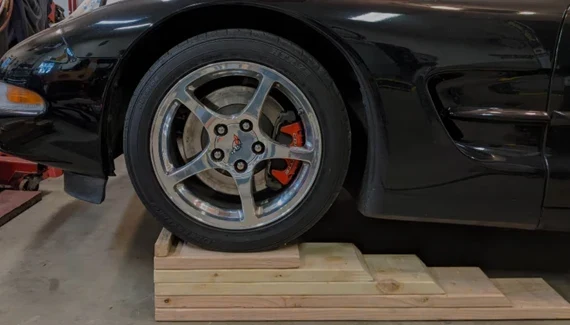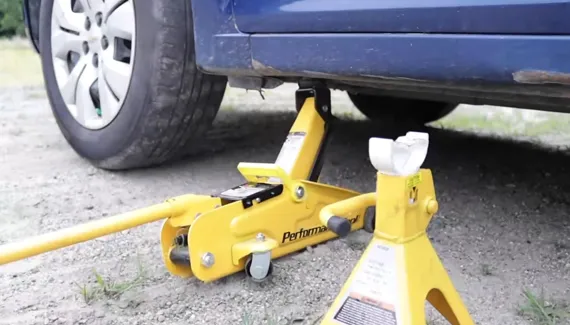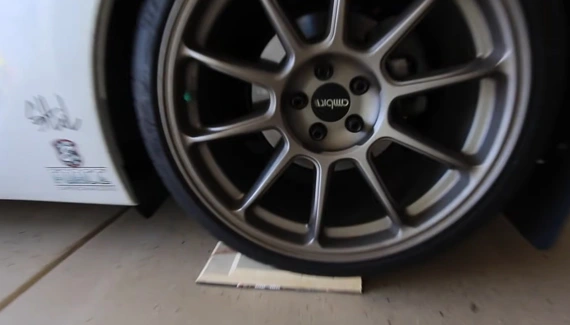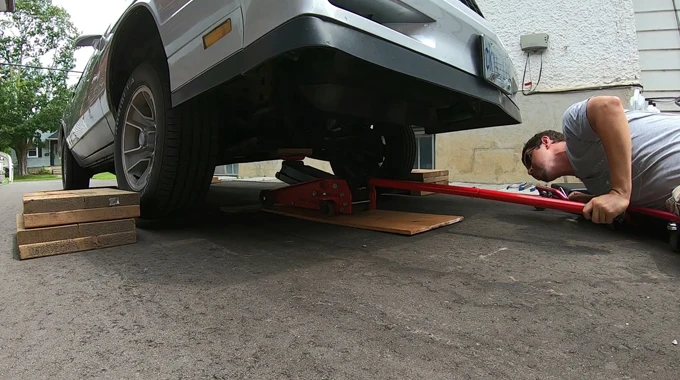Last Updated on July 5, 2023
Jacking up your car helps you do much of your car maintenance, like changing a tire or checking the brakes, but you have to be careful on sloped driveways. Using jack stands will allow you to support your vehicle. Besides making it easier to work under the car, they’re also safe.
When you jack up a car on a sloping driveway, the car could slip off the jack and cause serious injury. But how to jack up a car on a sloped driveway for safe car maintenance? You can use a hydraulic floor jack, jack stands, car ramps, or wheel chocks to support your car while performing vehicle servicing.
When placing jack stands, position them on a level surface to support the vehicle evenly. Check out the simple instructions for jacking up a car in sloped terrain and what to remember.
How to Jack Up a Car on a Sloped Driveway for Car Maintenance?

Car jacks typically have a ratchet mechanism that allows them to be raised slowly and steadily. This is important when lifting a car, as a sudden increase in weight could cause the jack to collapse. When used on a sloped driveway, car jack stands help to keep the car level and prevent it from rolling off the jack.
It may be necessary to jack up your car if you need to change your car’s flat tire or to change the engine oil. You’ll have to be careful if you have a sloped driveway. Here’s a step-by-step guide on how to do it:
Step 01. Park Your Car on Hard and Level Ground (If Possible)
A jack must be placed under the frame or suspension, preventing the car from toppling when it is jacked up. When using a hydraulic floor jack in a sloped drive, park the car on hard & level ground. Because on soft ground, the jack may sink into the ground when weight is applied and cause the car to topple over.
If you must park on a slope, ensure that the wheels are pointing straight ahead and that the parking brake is engaged. It will prevent the car from rolling off the jack stands and causing serious injury.
While most ICE cars such as Teslas are 100% insecure. The front wheels are free to roll regardless of whether the parking brake is applied or not.
Step 02. Place Wheel Chocks Behind the Opposite Wheels
Before you use a car hydraulic jack to lift your vehicle, it is essential to take some safety precautions. When you begin jacking up your car, place the wheel chocks behind the wheel opposite the wheel you are working on. This will help to prevent the vehicle from slipping off the jack stands.
Step 03. Position the Jack Under the Car’s Frame
Once the vehicle is securely in place, locate the jack points on your vehicle. These are usually located near the frame or under the doors. Place the jack at one of these points.
The best place to position the jack is under the car’s frame at a sturdy point. This is usually near the door sill or rocker panel. Once the jack is in place, you can lift the car.
Step 04. Slowly Turn the Jack Handle to Raise the Car
The car must be jack-up slowly and evenly, so the vehicle doesn’t become unbalanced and fall off the jack. The car should be raised high enough so the wheels are off the ground before you place the jack stands. If the vehicle is not raised high enough, it may roll off the stand and cause serious injury.
Once the car is raised, secure it with wheel chocks or other support forms before you begin working on it. This will allow you to work safely under your vehicle without worrying about slipping or falling. Remember, the longer the lever, the less force required to lift the car.
These steps will help you safely jack up your car on a hillside. Be sure to take all necessary safety precautions and follow the instructions carefully to avoid injury.
Can You Jack Your Car Up on a Slanted Driveway?

If you find yourself in a situation where your car is stuck on a slanted driveway, you may be wondering if you can jack the car up to get it out. The slope of the surface determines the answer. Generally, jacking up a car on a slope over 5 degrees isn’t a good idea, but jacks and car ramps are good on slopes under 5 degrees.
Also, if the slope is gentle and your car is lightweight, you may be able to jack it up without any problems. But, if the steep slope or your vehicle is heavy, jacking it up could cause the car to slide further down the driveway. In these cases, it’s best to call a tow truck or other professional assistance to help you.
How Do Car Jack Stands Work on a Sloped Driveway to Jack Up a Car?
You use jack stands to lift your car and keep it stable by gripping it at the jacking point. But how do they function on sloped driveways? The answer is simple: using the car’s weight to create a stable base.
When you place the jack stand on the driveway, the car’s weight presses down on the stand, holding it in place. Because of this, there’s no chance of the car sliding or falling off the jack, which could lead to severe injuries. When using jack stands on a sloped driveway, ensure you place them at the correct lifting points under the vehicle.
Once they are in place, you can release the hydraulic pressure from the floor jack, and the stands will support the car’s weight. As long as the stands are flat, they will provide stable support for your car. But, if they are not placed correctly or if they are not flat, they could fail and cause the car to fall.
That’s why you need to follow the instructions carefully (you must check the weight lifting range of your jack stand) and be sure to inspect the stands before using them. Your jack stands legs might need some rubber grip in sloped driveways.
How Big Should My Jack Stands be to Jack Up My Car on a Slope?

Choosing a suitable jack or axle stand is paramount for your and your vehicle’s safety. If you have a small light vehicle, you will need 2-ton (4,000 pounds) jack stands. For a medium to a large car or a medium SUV or camper, you will need 3-ton (6,000 pounds) jack stands.
And if you will be routinely working on a truck or large SUV, you will need 5 to 6-ton (10,000 to 12,000 pounds) jack stands. Along with the weight capacity, you also need to consider the height of the jack stand. Most car jacks lift a vehicle about 16 to 20 inches off the ground.
Yet, the jack may fall if the slope angle exceeds 5 degrees when jacking a vehicle. You can mitigate this risk using multiple jacks, jack stands, and wheel chocks. If you’re choking and jacking correctly, you will not have too much trouble with a 3-4 degree slope.
Ultimately, choosing the suitable jack stand is a matter of assessing your needs and understanding the capabilities of the different types of stands available.
What Type of Car Jack Can You Use for Oil Change on a Sloped Driveway?
When changing the car oil of your vehicle on a sloped driveway, it is important to use a car jack that is designed for such an uneven surface. In our best car jack for oil change review, we listed several features for each type of car jack to consider when changing the car oil.
One type of car jack that can be used for this purpose is a hydraulic bottle jack. This type of jack has a narrow base and a tall design which allows it to be placed on an inclined surface without wobbling.
Hydraulic floor jacks and low-profile floor jacks can also be used for oil changes on sloped driveways. But it is important to ensure that the jack has a stable base and is rated for the weight of your vehicle before making a purchase.
They come in features such as stability, weight capacity, and ease of use. A stable base is essential when working on a sloped driveway, and a jack with a high weight capacity is necessary to lift your vehicle safely.
Ease-of-use features such as a quick-release valve and easy-to-use handle can make the oil change process smoother and more efficient. Consider all of these features when selecting a car jack and prioritize safety and stability for a successful oil change every time.
What Type of Car Jacks Should I Use on an Incline?
Many people think that any car jack can be used on an incline, but this is not true. Using the wrong type of jack on an incline can be dangerous and result in your car slipping or falling off the jack. So, what type of car jack should you use on an incline? The answer depends on the angle of the incline and the weight of your car.
If you are jacking up a light car on a gentle incline, a car jack or scissor jack may be all you need. It’s advisable not to use a wheel car jack on sloped surfaces since they’re not designed for it. You might use a car jack without wheels and a much larger surface area if necessary.
You must use a ratchet jack when lifting a heavy car on a steep incline. Whatever type of jack you use, it is vital to make sure that it is planted firmly on the ground before you begin to lift your car.
Taking these precautions can help ensure that your car is appropriately supported and that you stay safe while performing this common maintenance task.
Do Sloped Driveways Pose Any Risks When Jacking Up A Car?
When jacking up a car, consider the risks involved on a steep driveway. You need to be aware of these risks:
- If the car is not adequately supported, it could roll off the jack and cause severe injury or damage. To avoid this, use jack stands to stabilize the vehicle securely before beginning work.
- Even if the car is securely jacked up, there is still a risk that the jack could collapse if the weight limits exceed the jack stand weight lifting capacity. For these reasons, it’s generally best to use secondary support, such as wheel chocks and multiple jack stands.
- If the car is lifted too high, it could become unstable and tip over. To avoid these risks, you should use a jack stand that is the appropriate height for your vehicle.
Precautions to Take When You Jack Up a Car on a Sloped Driveway

You should know that jacking up a car on an incline is not the same as jacking up a car on level ground. You must take extra precautions to ensure the car does not slip off the jack and hurt anyone.
If you’re planning on jacking up your car on a slope, here are a few things you’ll need to remember:
Park the car in a level area: Make sure the ground is level and firm before starting. If the ground is too soft, the jack could sink in and cause the car to tilt. The car could roll off the jack if the ground is too uneven.
Keep the car away from traffic: Make sure that the car is parked away from traffic. This will give you plenty of room to work and will help to prevent any accidents. Also, set up warning signs or cones around the area to warn other drivers.
Apply car brakes: Take safety precautions when jacking your car on a sloped surface. After all, you’ll be working underneath the vehicle, which puts you at risk of being injured if it should happen to slip or fall. Don’t forget to apply the brakes (such as emergency brakes) before you start. This will help to keep the car from rolling while you’re working.
Place blocks behind the tires: It’s a good idea to place blocks beneath the tires on the opposite side of the one you’re jacking up. That way, even if the jack should fail, the car will not be able to roll down the driveway and cause further damage.
Assemble proper lifting equipment: One of the most common mistakes people make is not assembling the proper lifting equipment. A hydraulic floor jack will be necessary for safely raising the vehicle, and you’ll also need a pair of sturdy jack stands to support it once it’s off the ground.
Read the user manual: Be sure to read your car’s and jack’s user manual before attempting to lift it. This will give you specific instructions on where to place the jack and how much weight it can safely support.
Use jack stands to support the car: Always secure the car with jack stands when it is jacked up, especially if you are on a sloped driveway. When you’re using jack stands, make sure to place them on a stable surface.
If you’re on a concrete driveway, that’s not usually a problem, but if you’re on dirt or gravel, it’s a good idea to put a piece of plywood under each stand. This will help to prevent them from sinking into the ground.
Do not rely on the jack alone: This safety tip is imperative to remember when jacking up a car or there is no secondary support. The jack is only meant to hold the car up temporarily.
Do not crawl under the car or stand on the jack itself, as this could cause it to collapse. In the event the jack fails, the car could fall and seriously injure or kill you.
If you remember these tips, jacking up a car on a downhill driveway will be a breeze. Just be sure to take your time and follow the instructions in your user manual. And, of course, always use jack stands for extra safety.
Conquer Steep Slopes: Follow These Steps for Easy Car Jacking
Jacking up a car on a sloped driveway can be tricky, but it can be accomplished with the proper technique and caution. Following those steps, you can safely lift your car off the ground and return it to the road in no time.
Never forget the importance of safety when dealing with jacks and cars. Take your time and closely follow the steps to ensure that you avoid any unwanted accidents. Get your car back on the road soon and drive safely!
